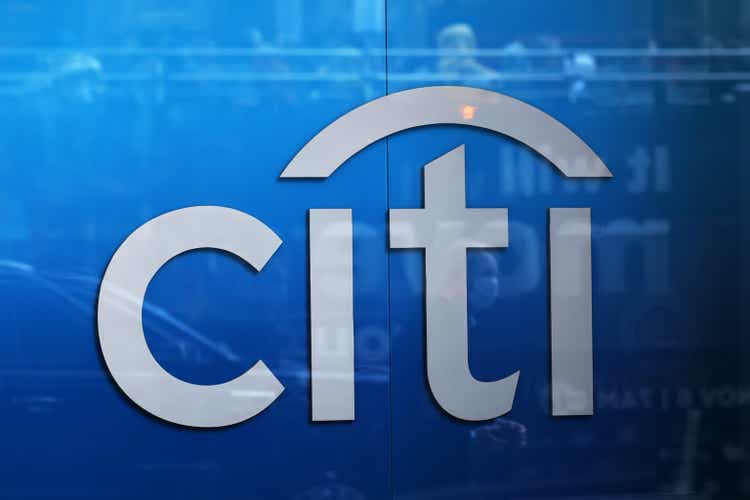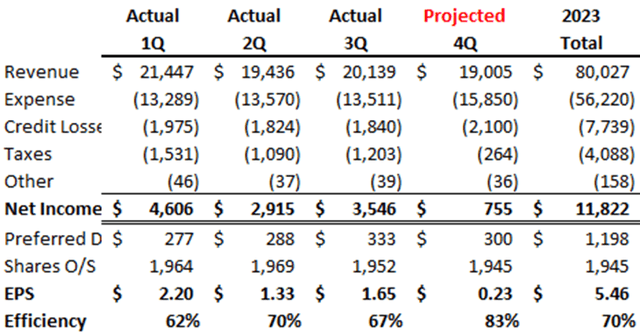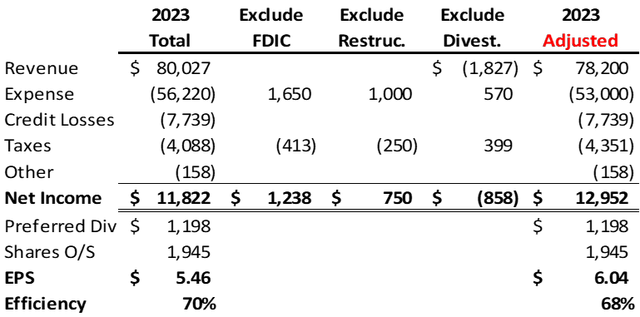Michael M. Santiago
Summary
Mark Mason presented recently at Goldman Sachs 2023 U.S. Financial Services Conference to furnish an update on expected 2023 financial results and Citi’s path to ROTCE of 11% – 12%.
Based on Mason’s guidance, we should expect a rough Q4 EPS release, when factoring in lower-than-expected revenues, a $1.65B FDIC charge, and $1.0B in restructuring charges. Full year EPS are likely to come in around $5.46 (or $6.04 excluding the charges).
Mason also laid out Citi’s path to attaining ROTCE of 11% – 12%, focusing on growing revenue 4% – 5% a year and cutting expenses by $1B – $2B.
The Update
Mark Mason, Citigroup CFO, recently spoke at the Goldman Sachs 2023 U.S. Financial Services Conference and provided updated financial guidance for 2023 and beyond. For anyone who hasn’t read the transcript, and is interested in C, I highly suggest reading it here as it contains a comprehensive update on Mason’s expectations and plans for reaching their 11% – 12% ROTCE target.
On the day the transcript was released (12/6/2023), C’s stock jumped higher by as much as 5% in early trading (on very high volume) before pulling back some. One of the reasons for the reaction, I believe, is that the guidance Mason provided included his expectation that expenses in 2024 would $51B – $53B, potentially $1B – $2B lower than 2023 expenses, with most of that reduction coming in Q3 and Q4. I’m a bit skeptical, but if Citi can hit that level of expense reduction next year, it would be very significant.
Hopefully we’ll have more details on exactly how they scheme to do it when they update us advance with the Q4 EPS release. For now, it’s a positive signal that Mason is pushing back against investor concerns over high expenses and reaffirming their ability to hit their goal of 11% – 12% ROTCE.
The Numbers
Mason guided to $78B on revenues, $54B on expenses, $7.7B on cost of credit and a 25% tax rate. The guidance is excluding the expected $1.65B FDIC charge and divestitures, but included $1.0B in restructuring charges.
The updated guidance results in the following unadjusted numbers:
The above Q4 projection includes the $1.65B FDIC charge, the $1.0B restructuring charge and income from divestitures. Excluding these items, we get the following:
As shown above, 2023 adjusted expenses are being guided to $53B excluding the FDIC charge, restructuring charges, and divestitures.
Capital and Buybacks
Basel III and potential changes to the CCAR process are two really big potential hurdles for Citi in terms of buybacks and ROTCE. All the big bank CEO’s, at the time of the Goldman Sach’s conference, were in DC testifying before Congress. For those interested on their comments, please see the SA articles here, and here. The CEO’s are pushing back as hard as they can. Where it goes, we’ll just have to expect and see.
Mason was questioned by host Richard Ramsden about it at the conference:
So, let’s talk a little bit about capital Basel III, obviously, it’s got a lot of attention at this conference. I know you’ve talked about a 16% to 19% enhance in CET1 based on the proposal. You’ve obviously had more time with the proposal now. So, can you just give us an update on your thought process around the ramifications of Basel III? Maybe talk a little bit about changes to the proposal that you think may happen to the extent you think that it could change relative to the initial regulate. But then maybe also talk a little bit about mitigation strategies that we should think about when we’re thinking about steady state capital for Citigroup going forward?
Mason expressed significant concerns regarding how Basel III could negatively impact operational risks, CCAR modeling and compliance, and private equity risk weightings that could jump 100% to 400%. All these potential impacts, if they happen, would guide Citi to have to take mitigating steps:
All of those activities potentially impact the way we think about pricing, the way we think about collateral that’s required against positions. In the way we think about how much we want to be in those different types of businesses, and so we’ll have to handle that. I think the real takeaway here is that two things. One, the numbers that I’ve given [16% – 19% increase in CET1] have assumed no mitigation . Mitigation involves everything again from how we think about repricing to how much collateral we need to hold to whether we want to be in the business and at what level or not. We’re looking at all of those things to ensure that we’re ready for however the regulate evolves and whatever that means in terms of its implementation.
As mentioned in my prior article (here), given the uncertainty regarding capital rules, Citi has buybacks basically on a trickle when netting against employee stock issuance. They are at a run rate of about a paltry $500M a quarter (prior to employee issuance). Mason confirmed that’s about where they’re at in Q4:
I talked about buybacks, we’re doing buybacks in the quarter, we’re probably doing around $500 million or so well into that for the quarter. And I continue to look at it every quarter with an eye towards how the capital regime is continuing to evolve, how much I need to invest in the businesses to capture the growth and ensure improved returns, and then how much I can buy back. And given where we’re trading, we want to buy back as much as we can. And we’ve been trying to do that responsibly.
ROTCE Goal of 11% – 12%
Investors, myself included, have been highly skeptical that Citi can reach its ROTCE target of 11% – 12% anytime soon. Richard Ramsden questioned Mason on that as well:
So, let’s just talk about the targets because look, I think there is still this question mark around how you get from the current returns to the target of 11% to 12% RoTCE by 2025. And certainly, when you look at consensus, they’re not at those levels. You’ve obviously talked a lot about the restructuring reorg, about the ability to grow the business even if interest rates don’t go up. So maybe you can help us pull this together and bridge the gap in terms of how you think about the path to those returns versus the market. Maybe talk about what you think investors could be missing, because I do think it is a very important part in terms of the rerating of Citigroup’s value.”
Mason made it clear that the key to getting there is growing their revenue 4% – 5% a year and keeping a lid on expenses:
We can do [that] — I just walked you through on the revenue line, how I thought we could preserve 4% to 5%. So, we are solving for 11% to 12%, by trying to figure out what our expense level needs to be. So, when you run that math, that would suggest expenses of $51 billion to $53 billion. I said for 2023, we are at roughly $54 billion with $1 billion or so of repositioning/restructuring charge in it, that’s $53 billion. So, it seems reasonable, it seems doable that we would be able to get to $51 billion to $53 billion in our illustrative example of 2026 with the expense levers that I have discussed, those three levers, in order to reach kind of an 11% to 12% return.
With expense cuts of $1B – $2B and revenue growth of 4% – 5%, Mason thinks he gets there by 2026. And if the revenue growth doesn’t pan out, then he’ll just have to cut expenses even more:
And again, we can debate. What if you don’t do 4% to 5%? Well then, that reduction of $1 billion or $3 billion, I probably have to do some more on that. But those levers to me seem reasonable to reach.
Final Thoughts
The biggest takeaway of Mason’s guidance at the Goldman Sachs conference, in my opinion, was his dropping that they think they can cut expenses by $1B – $2B starting in the second half of 2024. It gives investors at least some idea of where they think they can go in terms of getting expenses back down. If you add 4% – 5% revenue growth, which Mason defended vigorously, then they could easily grow EPS quite substantially in the next couple years.
Whether they can get to their ROTCE goal soon is debatable. Getting there quickly will demand them meeting their revenue growth goals, which I’m somewhat skeptical of. But even if they don’t get there right away, and as a result don’t get a valuation re-rating for another couple years, the EPS growth alone just from cutting expenses adds to the upside potential of the stock even at its current valuation rate.
Hopefully we’ll hear more details in the Q4 EPS release, but for now, Mason’s comments are a positive signal they have specific numbers in mind, fairly large ones, when it comes to cutting expenses.





